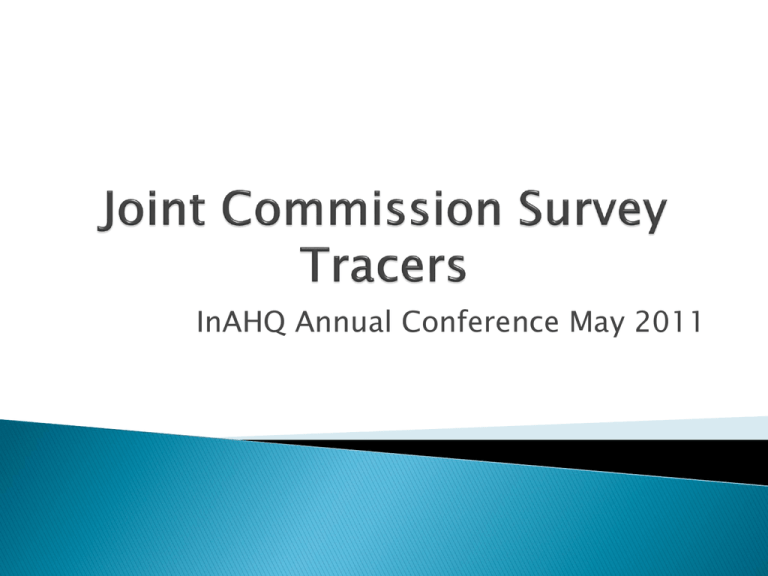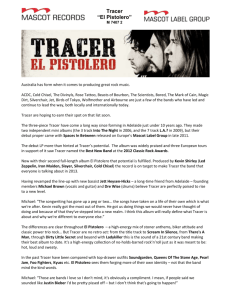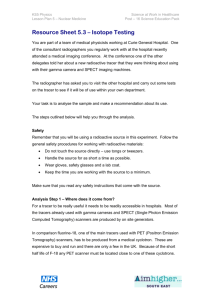Joint Commission Survey Tracers
advertisement

InAHQ Annual Conference May 2011 Identify techniques for developing tracer Identify how to use tracers to improve organizational readiness Demonstrate how to conduct a tracer ◦ To provide an accurate assessment of the systems and processes for the delivery of care, treatment, and services ◦ Identify gaps or risk points that could affect quality or safety of care ◦ Link to TJC elements of performance ◦ Learn from individuals directly involved in providing/receiving services about how the process work • Retrospective-learn more about why a process didn’t work or was successful • Prospective-evaluate process identified as problematic, determine current practice around new regulatory standards, evaluate high risk populations or processes with poor outcomes • • • What would you like to know more about in your organization What do you worry about What keeps you awake at night Systems Tracers – process focused ◦ Infection Control ◦ Medication Management ◦ Use of Data Patient Tracers - patient-focused (PPR and Priority Focus Areas) Program Specific Tracer – Hospital • Hospital – lab integration is topic – consistent application of critical value, specimen collection and handling, etc. • Hospitals with psych – Suicide prevention to include effectiveness of HCO suicide prevention strategy. • Patient flow tracer • Relates to specific types of services offered or programs being accredited • Ambulatory • Behavior Health • Lab integration • Home Health Tracers provide ◦ Unique opportunity to see the care and services on a daily basis ◦ Better understand relevancy of process ◦ Detect problems that could increase risk/compromise patient safety ◦ Cost effective approach to improve safety and quality ◦ Team approach-who should be on team ◦ Team leader-suggest co-leaders ◦ Provide Guidance and training for tracer team ◦ Channel information to leadership Who should be on the team? ◦ Performance Improvement ◦ Nursing leaders ◦ Pharmacy ◦ Infection control ◦ Facilities ◦ Determine Goals PI data Sentinel event Sentinel event alerts Confirm practices of key policies Confirm practices of NPSG and UP What unique situations exist in your organization Clinical Service Groups and Priority Focus areas ◦ Select tracer patient Use active patient list LOS 4-7 days nearing discharge Considerations Complex situations ICU ED Anesthesia services Surgery Use Multiple approaches and sources Interview Read Observe Interview ◦ Choose opening, welcoming tone ◦ Listen attentively ◦ Restate or clarify responses ◦ Ask open ended questions Interview questions ◦ Use PPR chapter elements of performance as a guide ◦ Use national survey questions ◦ Ask multiple staff the same question ◦ Have staff answer questions not managers NPSG ◦ Tell me your two patient identifiers Observe the process of using patient identifiers Medication administration Specimens Testing Pain assessment and reassessment Is there evidence in the medical record the patient has been reassessed for pain per policy What is the process for pain assessment and reassessment How often is pain assessed or reassessed Data collection ◦ Develop tools Standardize check list Department relevant standards Measure of success measures Tools need to help organize findings ◦ Aggregate data • Share data with leadership • Develop action plans • Set a timeline and reporting dates Compliance Issue Standard Action Date Completed Tracer Activity Visits For selected patients – visits are focused around the patient’s care and identified priority focus areas Utilizing tracer methodology will begin and end in the patient’s current unit Medical Record review at the end of visit to validate processes and documentation Classic Tracer Activity: Visit the current unit to get a brief history of the patient and identify what services were involved in their care Trace back to units or services who cared for the patient, discussing various processes with unit staff. (may include lab, radiology, ED, Cath Lab, pharmacy, PT, etc.) Notify the manager or charge nurse of the patient you have chosen to trace Request patient record ◦ Be sure to get bedside record if appropriate and current MAR Ask to have the patient’s nurse assist you with chart review ◦ To decrease time staff is away from their patients you may wish to review part of the record alone. ◦ Also allows time to formulate questions Focus on high risk processes ◦ What is the process ◦ Trace the process ◦ Look for risk points Process changes ◦ People, equipment ◦ IT, sequence of procedures, locations Reports or data will indicate an issue Reviewing the process not an individual patient Where does the process touch Who does the process touch Infection control ◦ Learn about planning, implementing, evaluating infection control program ◦ What is the process used to reduce infections Proper hand washing Standard precautions Transmission based precautions Sterilization processes Identify safety concerns within different levels and types of care Ambulatory-continuity of care Behavior Health-elopement, suicide prevention Home Health-falls, equipment 26 year old male admitted to ICU via ED after MVA. Patient has been to surgery for repair of orthopedic injuries and is on a vent. The patient’s history includes diabetes and he drinks a 6 pack of beer per day. Plan is to move the patient to a surgical floor tomorrow. What would you look for on the patient’s medical record? Which staff members would you speak to on the unit? Which departments might you visit as you continue the tracer? Start in ICU and track to ED and surgery H&P – done prior to surgery or a note indicating it is an emergency All surgery related paperwork complete? Consult with dietitian? Consideration of DTs? Restraints used? Documentation? Speak with RT, PT, Dietitian Is care plan customized to the patient? 56 year old female post 3 vessel open heart procedure. Patient was admitted via the ED and went to cath lab and subsequently on to OR. Patient is now in a telemetry unit but was in MICU prior to that transfer. Nursing assessment indicates the patient’s faith is very important to her in her recovery. The patient only speaks Spanish. What would you look for on the patient’s medical record? Which staff members would you speak to on the unit? Which departments might you visit as you continue the tracer? Start in telemetry and visit MICU, ED, cath lab and OR Interpreter available? Written material such as consent available in Spanish? Staff know how access to interpreter Chaplain or priest notified if patient requests? Cath lab and OR documentation indicate timeout? • Don’t trace your own department • Trace processes of care not clinical appropriateness • Failure to take notes • Failing to summarize findings • Lack of validation • Lack of feedback to staff Understand Tracer Methods Have a plan Follow through using your PI model Incorporate into annual PPR plan Questions Every level of the organization is involved Questions











